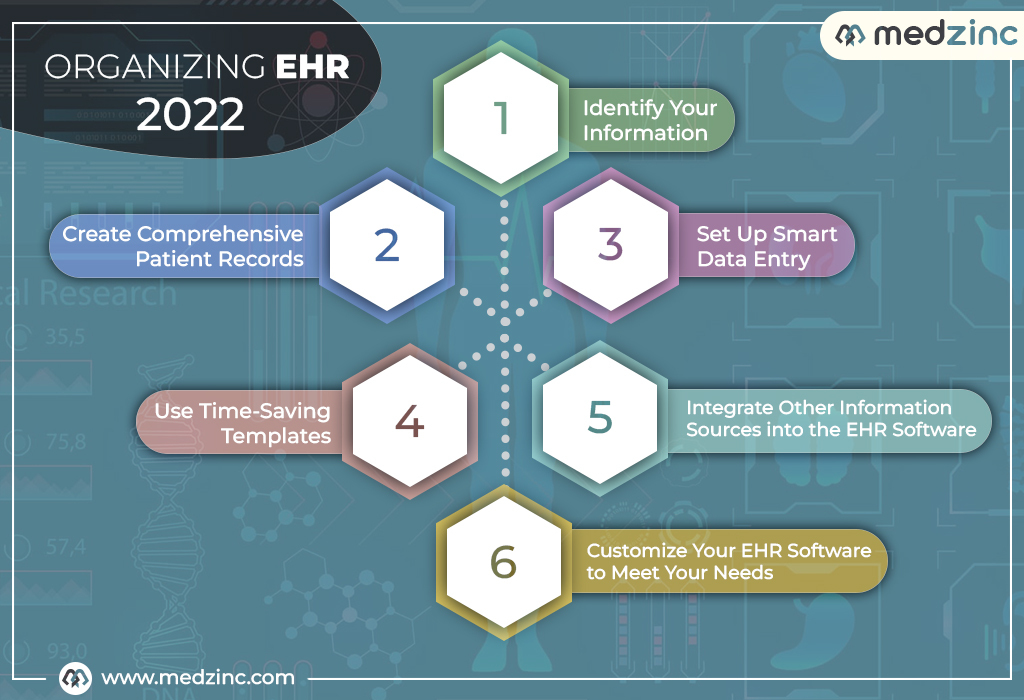
Tips for Organizing EHR in 2022
Every clinical practice functions in an unexpected manner. To get the most out of coordinating electronic health records, you should tailor your EHR programming to your specific needs. Moreover, to improve your clinical practice, you must distinguish between necessities and requirements. Furthermore, this allows you to see how you can tailor your EHR programming to your clinical practice. To make EHR organization easier for your Clinical Practices. Medzinc's newest blog addition, "Tips for Organizing Ehr in 2022," is here to provide you with the most recent Tips for Organizing Ehr.
Why is it important to have Tips for Organizing EHR in your mind?
The primary reason for keeping clinical records is to ensure optimal patient well-being and care coherence. Moreover, when it comes time to share patient data with other medical care providers, clinical records ensure that your patient receives the proper attention. Furthermore, the significance of clinical record maintenance goes beyond a passing thought. Keeping clinical records can also help you in the following situations:
- Malpractice lawsuits
- Billing audits
- Licensing board complaints
- Peer review inquiries
- Governmental investigations
Risk Involved in Poor management of the Electronic Health Records
Here are a few risks that the electronic health records present:
- Inhibits access to essential patient information
- Lowers workplace efficiency
- Increased risk of conflicting reports
- Billing error potential
Tips for Organizing EHR ( Electronic Health Records)
Identify Your Information
The first tip of Tips for Organizing EHR is to Identify Your Information. As some clinical data changes frequently, other information remains the same for the duration of the patient's relationship with your facility. Moreover, you must first recognize your data and sort it into two distinct gatherings based on how frequently you will need to refresh it. There is Two type of Information: Static information: This type of data changes or fluctuates only once in a blue moon. Furthermore, static data contain patient names, family names, dates of birth, NHS numbers, protection numbers, and other information. Dynamic information: Dynamic data changes in response to changing conditions. Furthermore, it may include arrangement dates, drug treatments, conclusions, references, and other comparative information.
Create Comprehensive Patient Records
It is simple to organize extensive patient records using EHR programming, gathering and storing. All you need is a smidgeon of preparation. In essence, even an incomplete patient clinical record contains a wealth of static data that can be used to effectively generate various reports. Moreover, the incomplete records may contain information which may prove useful in future. Therefore, any data should not be discarded without proper reviewing. Moreover, to properly generate reports in the future, each record should now include the following static data that aids in patient identification:
- Patient full name.
- Date of birth.
- Contact details.
- Home address.
Set Up Smart Data Entry
If you want to make coordinating electronic health records a breeze, you'll need to set up a smart information section. Moreover this will increase the amount of robotized information. Furthermore, a knowledgeable information section can help your clinical practice productivity by assisting you in saving time and effort.
Use Time-Saving Templates
One of the significant advantages of utilizing EHR programming is exploiting efficient templates. Moreover, it is similar to shrewd information passage instruments, formats assist you with computerizing information input by reusing rehashed data.
- Immediately sort through reports given the kind of layout used to create the archives.
- Effectively compose texts and messages to your patients with custom formats.
- Take counsel notes quicker than any time in recent memory.
- Limit blunders in information passage.
- Guarantee that all records incorporate the critical static data.
- Decrease staff responsibility and lift your clinical practice's productivity.
- Save time on creating and arranging electronic wellbeing records and patient graphs.
Integrate Other information Sources into EHR
Arranging electronic health records within EHR software allows you to effectively integrate other data sources into the framework. Moreover, this helps in proper segmentation of data available. Furthermore, as an example, you can connect your EHR programming to various frameworks used by research facilities or other relevant offices with which you collaborate.
Customize Your EHR Software as per your needs
Every clinical practice functions in an unexpected manner. Moreover, to get the most out of sorting out electronic health records, you should customize your EHR programming to your specific needs. Recognize your prerequisites and requirements to improve the effectiveness of your clinical practice. Moreover, from there, you can see how you can tailor your EHR programming to your clinical practice. We post such informational contents regularly. Do check out our other Blogs.
Related Post
No results.